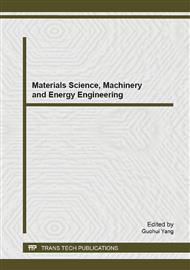[1]
F.L. Zhao, Y.F. Wang and C.L. Dai: Techniques of enhanced oil recovery after polymer flooding. Journal of China University of Petroleum: Edition of Natural Science, Vol. 30 (2006), pp.85-89.
Google Scholar
[2]
S.K. Li, Y. Zhu and Y.S. Zhao: Evaluation of pilot results of alkali-surfactant- polymer flooding in Daqing Oilfield. Acta Petrolei Sinica, Vol. 26 (2005), pp.56-59, 63.
Google Scholar
[3]
Y.Y. Zhu, Q.F. Hou and W.D. Liu: Recent progress and effects analysis of ASP flooding field tests. SPE 151285 (2012).
Google Scholar
[4]
Y.G. Liu, Q. Lu and J.G. Wang: Research on EOR by binary combination flooding in Jinzhou 9-3 Oilfield. Petroleum Geology and Recovery Efficiency, Vol. 16 (2009), pp.68-73.
Google Scholar
[5]
F.L. Zhao: Oilfield Chemistry (Petroleum University Publishing House, China 2000).
Google Scholar
[6]
Y.F. Wang, F.L. Zhao and B.J. Bai: Optimized surfactant IFT and polymer viscosity for surfactant-polymer flooding in heterogeneous formations. SPE 127391 (2010).
DOI: 10.2118/127391-ms
Google Scholar
[7]
F.G. Zhao, X.A. Yue and J.R. Hou: Impact of alkali on emulsification of compound flooding system and crude oil. Petroleum Drilling Techniques, Vol. 38 (2010), pp.62-66.
Google Scholar
[8]
Y.Y. Zhu, Y. Zhang and J.L. Niu: The progress in the alkali-free surfactant-polymer combination flooding technique. Petroleum Exploration and Development, Vol. 39 (2012), pp.346-351.
DOI: 10.1016/s1876-3804(12)60053-6
Google Scholar
[9]
P.L. McGuire, J.R. Chatham and F.K. Pask van: Low salinity oil recovery: an exciting new EOR opportunity for Alaska's North Slope. SPE 93903 (2005).
DOI: 10.2118/93903-ms
Google Scholar
[10]
P. Jiang, G.C. Zhang and J.J. Ge: Progress in the research of wettability reversal mechanism. Journal of Xi'an Shiyou University: Natural Science Edition, Vol. 22 (2007), p.78~85.
Google Scholar
[11]
D. Wang, H. Xia and S. Yang: The influence of visco-elasticity on micro forces and displacement efficiency in pores cores and in the field. SPE 127453 (2010).
DOI: 10.2118/127453-ms
Google Scholar
[12]
J.R. Hou, Z.C. Liu and S.F. Zhang: The role of viscoelasticity of alkali/surfactant/polymer solutions in enhanced oil recovery. Journal of Petroleum Science and Engineering, Vol. 47 (2005), p.219– 235.
DOI: 10.1016/j.petrol.2005.04.001
Google Scholar
[13]
G. Wang, D.M. Wang and H.F. Xia: Mechanism for enhancing oil-displacement efficiency by betaine surfactant after polymer flooding. Acta Petrolei Sinica, Vol. 28 (2007), pp.86-90.
Google Scholar
[14]
G.X. Zhao: Principles of Surfactant Action (Chinese Light Industry Press, China 2003).
Google Scholar
[15]
D.M. Wang, C.D. Liu and W.X. Wu: Development of an ultra-low interfacial tension surfactant in a system with no alkali for chemical flooding. SPE 109017 (2008).
DOI: 10.2118/109017-ms
Google Scholar
[16]
Z.H. Sui, J.K. Qu and S.C. Lu: Study of salt resisting surfactant oil displacement system. Advances In Fine Petrochemicals, Vol. 3 (2002), pp.35-38.
Google Scholar
[17]
K.A. Elraies, I.M. Tan and M. Awang: A new approach to low-cost, high performance chemical flooding system. SPE 133004 (2010).
DOI: 10.2118/133004-ms
Google Scholar
[18]
R. Kumar, K.K. Mohanty: ASP flooding of viscous oils. SPE 135265 (2010).
Google Scholar
[19]
V.L. Kolev, I.I. Kochijashky and K.D. Danov: Spontaneous detachment of oil drops from solid substrates: governing factors. Journal of colloid and interface science, Vol. 257 (2003), pp.357-363.
DOI: 10.1016/s0021-9797(02)00052-8
Google Scholar
[20]
P.Y. Wang: Surfactants-Synthesis • Performance • Application (Chemical Industry Press, China 2012).
Google Scholar
[21]
R.R. Reza, S. Skule and T. Austad: Combined surfactant-enhanced gravity drainage (SEGD) of oil and the wettability alteration in carbonates: the effect of rock permeability and interfacial tension (IFT). Energy&fuels, Vol. 25 (2011).
DOI: 10.1021/ef200085t
Google Scholar


